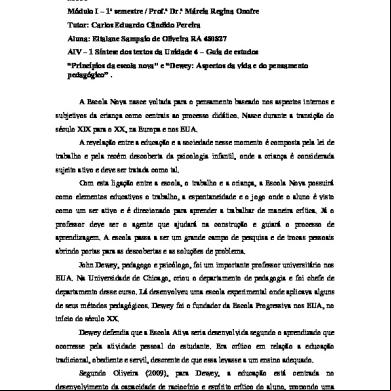Aiv Test 55w6m
This document was ed by and they confirmed that they have the permission to share it. If you are author or own the copyright of this book, please report to us by using this report form. Report 3b7i
Overview 3e4r5l
& View Aiv Test as PDF for free.
More details w3441
- Words: 660
- Pages: 3
DISCUSSION Toughness is the property of a material to resist impact. Due to movement of vehicles on the road, the aggregates are subjected to impact which causes them to break into smaller pieces. So, the aggregates that are going to be used in the road or highway must have sufficient toughness where the AIV test should be 10%-20%, to resist their disintegration due to impact. From the data obtained and the Aggregate Impact Value Test (AIV) that we have done, it shows that our mean value from all three samples is 22.11%. Based from the Aggregate Impact Standard, for the aggregate impact value of 21.11% which is 20% - 30% is satisfactory strong for road surfacing. It shows that this aggregate is satisfactory in term of impact value of the road aggregates and it’s suitability in road construction on the basis of impact value. A lot of advantages can be obtained from the AIV test, and one of the advantages of aggregate impact test is that the test equipment and the test procedure are simple and it can obtain the resistance and impact of stones simulating field condition. The test also can be done in short period of time whether it is at construction site or stone quarry. Higher resistance to impact can be provided in well-shaped cubical stones compared to flaky and elongated stones. On the other hand, volume and height may vary depending on specific gravity of aggregate and shape factors. So the specified rate of application of the blows of the impact rammer may be also varying. There are some errors that may occurred in the experiment and effects the result such as different data will be collected when the weighting process because of wind resistance. The sample data may be higher or lower than the reading data because of the reading error. Beside that, the distance of the person hand while tamping may cause different result. Tamping layer also can affect the error reading because it’s done manually and not consistence with the others. Then, the brass plate are not closed may cause reduction to the weight of sample after being crushed. The aggregate will fall out from brass plate because of the hammer was released freely and fall on the aggregate. The height of hammer and brass plate can also be the factor to the error data. For the precaution, laboratory must been closed area especially at the measuring area to avoid the wind resistance affected the weight data or closed box of measuring machine. Second, to avoid error to the sample data. Only one person with consistence strength and distance can reduced the error. It’s more effective if can be doing
using a machine than manually. The brass plate must been in closed machine to make sure that the sample not fall out from brass plate. Hammer must in same size with the brass plate to ensure that the aggregate are crash accurately.
CONCLUSION After conducting this experiment, we can say that it is important to test the aggregates in order to construct a quality pavement for the highway construction. Thus, the result of the experiment, the aggregates impact value are 23.26% , 21.08% and 22% for 3 samples that we conducted respectively. This value is acceptable because it is between 20-30% which classified as satisfactory for road surfacing. The lower the value, the higher the strength of the road surface. On the other hand, the objective of this experiment is achieved.
DATA RESULT Sample Weight of steel
1 3100
2 3100
3 3100
cylinder (g) Weight of aggregates
3419
3435
3422.7
+ cylinder (g) Weight of
319
335
322.7
aggregates, M1 (g) Weight of aggregates
318
334
318.9
after 15 blows (g) Weight of aggregates
74.2
70.6
71
(g) Weight retained
241.5
262.9
246
2.36mm, M3 (g) Total weight of
315.7
333.5
317
aggregates (M2+M3) M1-(M2+M3) AIV
3.3g 23.26%
1.5g 21.08%
5.7g 22%
2.36 mm, M2
Formula: AIV =
M2 ×100 M1
using a machine than manually. The brass plate must been in closed machine to make sure that the sample not fall out from brass plate. Hammer must in same size with the brass plate to ensure that the aggregate are crash accurately.
CONCLUSION After conducting this experiment, we can say that it is important to test the aggregates in order to construct a quality pavement for the highway construction. Thus, the result of the experiment, the aggregates impact value are 23.26% , 21.08% and 22% for 3 samples that we conducted respectively. This value is acceptable because it is between 20-30% which classified as satisfactory for road surfacing. The lower the value, the higher the strength of the road surface. On the other hand, the objective of this experiment is achieved.
DATA RESULT Sample Weight of steel
1 3100
2 3100
3 3100
cylinder (g) Weight of aggregates
3419
3435
3422.7
+ cylinder (g) Weight of
319
335
322.7
aggregates, M1 (g) Weight of aggregates
318
334
318.9
after 15 blows (g) Weight of aggregates
74.2
70.6
71
(g) Weight retained
241.5
262.9
246
2.36mm, M3 (g) Total weight of
315.7
333.5
317
aggregates (M2+M3) M1-(M2+M3) AIV
3.3g 23.26%
1.5g 21.08%
5.7g 22%
2.36 mm, M2
Formula: AIV =
M2 ×100 M1










